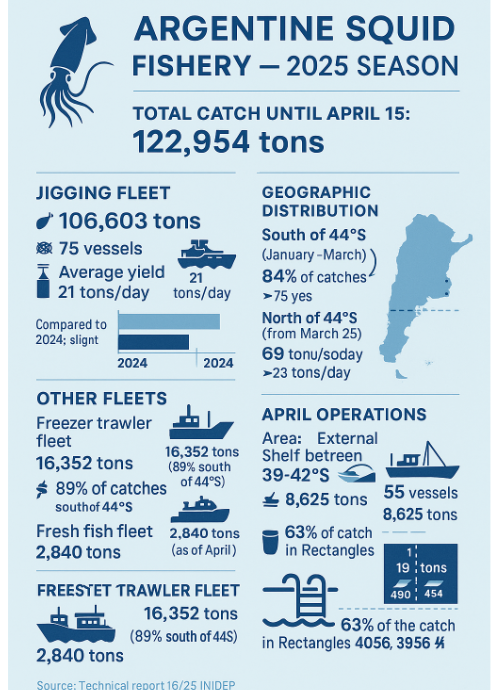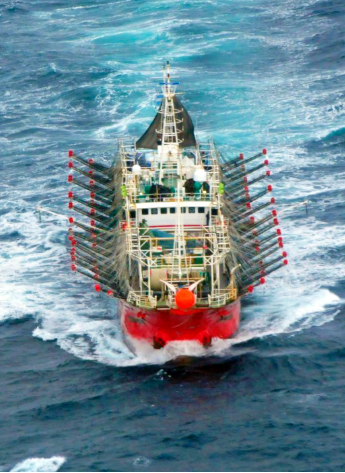|

Photo: Revista Puerto/FIS
Argentine Squid Fleet Exceeds 100,000 Tons in Early Season
 ARGENTINA
ARGENTINA
Wednesday, April 30, 2025, 00:10 (GMT + 9)
An INIDEP report details the performance and distribution of Argentine squid catches up to mid-April, with a daily average of 21 tons for the jigging fleet, as reported by Revista Puerto in its edition today.
The Argentine jigging fleet has already captured over 100,000 tons of squid (Illex argentinus) in the first fifteen weeks of the current fishing season, according to Technical Report No. 16 prepared by the Cephalopod Fisheries Program of INIDEP, with data updated to April 15th. This is highlighted in today's edition of Revista Puerto
(1).jpg)
The INIDEP report, led by Marcela Ivanovic, reveals that the total Argentine squid catch reached 122,954 tons up to the aforementioned date. Of this volume, the jigging fleet, comprising 75 vessels, contributed 106,603 tons, maintaining an average yield of 21 tons per fishing day.
These central data are derived from INIDEP Technical Report 16/25, where researchers analyzed the information from weekly fishing reports submitted by the 75 vessels, which accumulated a total of 5,002 fishing days over 233 trips.
According to INIDEP's analysis, the catch numbers are slightly lower than the performance of the 2024 season, where the jigging fleet had recorded a daily average of 24 tons of squid up to the 16th week of the season. During the analyzed period in 2025, 84% of the catches were concentrated south of the 44°S parallel, between January and March, in the Southern Management Unit, where the 75 jigging vessels extracted 89,708 tons at a rate of 21 tons per day

Fishing activity in the northern management area was authorized on the afternoon of March 26th. In this zone, a decrease in fishing effort was observed, with 69 jigging vessels reporting catches totaling 16,894 tons, with an average of 23 tons per day.
Regarding other fleets, the freezer trawler fleet declared catches of 16,352 tons, with 89% of its extraction carried out south of the 44°S parallel. For its part, the fresh fish fleet, according to data from the Undersecretariat of Fisheries up to April 22nd, reported landings of 2,840 tons.

INIDEP's Technical Report also details the estimation of fishing activity in the area adjacent to the Exclusive Economic Zone (EEZ), south of the 44°S parallel, where up to 206 jigging vessels were counted operating in week 14, mainly concentrated in rectangles 4660/4760.
"North of 44°S, the presence of eight vessels was observed in the same week, operating in rectangles 4157 and 4258," the document accessed by Revista Puerto expands. The number of jigging vessels within the EEZ disputed with the United Kingdom was estimated at 107 for the same week, fishing mainly in rectangle 5163.
During April, the fleet operated mainly on the outer shelf between 39-42°S, where 55 vessels captured 8,625 tons, with a daily average of 19 tons. 63% of the total catch in this area was recorded in three specific rectangles: 4056, 3956, and 4158. "At the time of writing this report, the fleet continues to operate in the area," the INIDEP scientists revealed.
(1).jpg)
The analysis of the squid caught between 39-42°S showed mantle lengths between 18 and 27 centimeters, an average weight of 208 grams, and a predominance of males in maturation and incipient maturity, while the females were mostly immature. These characteristics allowed this catch to be identified as belonging to the Buenos Aires-North Patagonian stock (SBNP), whose exploitation began in rectangle 4460, the southern end of its distribution area, from week 10 of the season.
Finally, INIDEP researchers determined that the accumulated catch up to week 15 of the current season reaches 97% of the total catch recorded in the 2024 season for the same period, and doubles the accumulated catch during 2023 for the same week.
editorial@seafood.media
www.seafood.media
|



